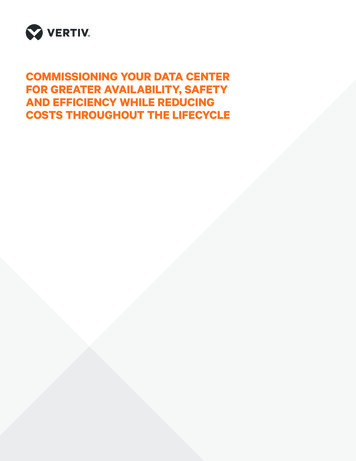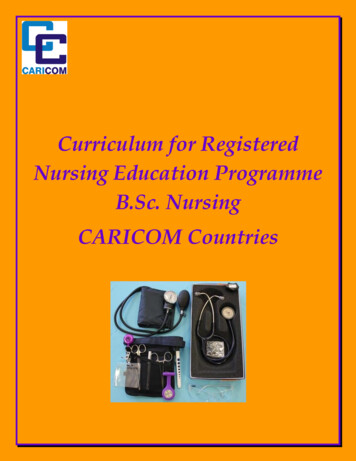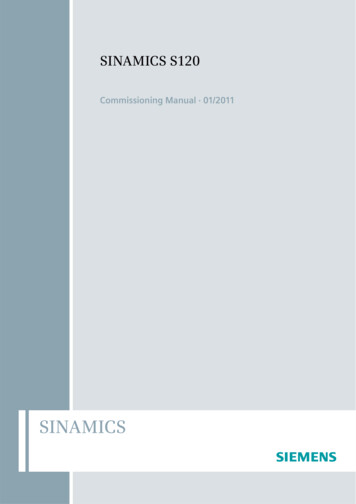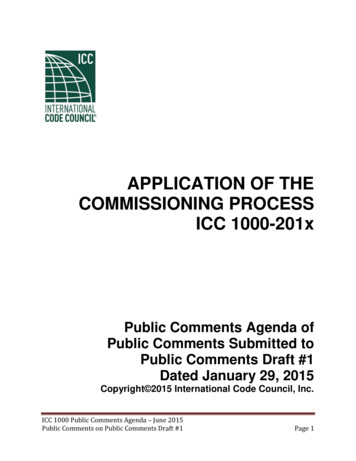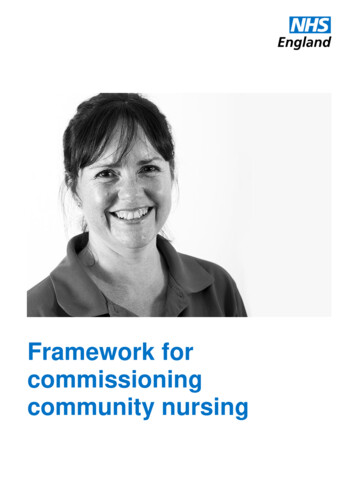
Transcription
Framework forcommissioningcommunity nursing
OFFICIAL2
OFFICIALFramework for commissioning community nursingVersion number: 1.0First published: October 2015Prepared by: Kathryn Evans, Community Nurse Advisor, NHS England, with advicefrom the Community Workforce Expert Reference Group (Appendix 1).Classification: OFFICIALThe NHS Commissioning Board (NHS CB) was established on 1 October 2012 as anexecutive non-departmental public body. Since 1 April 2013, the NHSCommissioning Board has used the name NHS England for operational purposes.NHS England’s purpose is to create the culture and conditions for health and careservices and staff to deliver the highest standard of care. To ensure that valuablepublic resources are used effectively to get the best outcomes for individuals,communities and society for now and for future generations.When this framework is implemented locally, commissioners and providers shouldpay due regard to the Public Sector Equality Duty (section 149 of the Equality Act2010) and to the need to reduce inequalities between patients in access to healthservices and the outcomes achieved (Health and Social Care Act 2012). Servicedesign should be appropriate and accessible to meet the needs of diversecommunities.Guidance for NHS commissioners on Equality and Health Inequalities legal dutiescan be accessed ub/legal-duties/3
OFFICIALContentsContents . 41Introduction . 52Purpose . 63Current context . 64Key characteristics of community nursing . 75Key factors affecting delivery of community nursing services . 96Diagram 1 - Factors affecting community nursing services delivery . 9The eight components for commissioning community nursing . 10Diagram 2- Components for community nurse commissioning . 10Component 1: Focused on health needs - now and the future . 11Component 2: Person centred outcome based commissioning . 12Component 3: Behaviour change and self-care . 14Component 4: Leadership and governance . 15Component 5: Quality . 16Component 6: People and culture . 17Component 7: Technology . 18Component 8: Effective workload management . 197 Workforce planning tools . 228Diagram 3 - Matrix of tools and focus. 23Next steps . 249References . 2510 Useful resources . 2711 Appendix 1 - Community Workforce Expert Reference Group Members . 2912 Additional consultation respondents . 304
OFFICIAL1 IntroductionThis framework has been developed as part of the Transforming Nursing forCommunity and Primary Care Programme (TNfCPC), the Senior Responsible Officerfor the programme is Jane Cummings, Chief Nursing Officer England. The frameworksupports commissioning of community nursing in response to the Five Year ForwardView. It focuses on community nursing whilst recognising that greater integration forhealth and social care will be needed to meet future needs.Community nursing1 refers to a diverse range of nurses and support workers whowork in the community, including district nurses, intermediate care nurses,community matrons and hospital at home nurses. It does not specifically includegeneral practice nurses, community mental health, learning disability or children’snurses although is transferable and all are central to integrated working.The Five Year Forward View (1)2 outlines thechallenges faced by the health and socialcare system in response to an ageingpopulation with increasingly complex andmultifaceted health and wellbeing issues.Delivering the strategic vision of the FiveYear Forward View requires a ‘joined up’approach for effective commissioning anddelivery of community nursing services.What is community nursing?Community nursing encompasses adiverse range of nurses and supportworkers who work in the community.This framework focusses oncommunity nurses providing care forthe over 18’s encompassing thedistrict nursing service, communitymatrons, intermediate care andspecialist nurses as examples.Subject experts and partner organisations(Appendix 1) have contributed to thedevelopment of this framework forcommissioning community nursing within thecurrent health and social care context. Theyhave identified the key characteristics of acommunity nursing workforce and the mainchallenges for community nursing services.The framework is based on these challenges and in response to the emerging newcare models, part of the Five Year Forward View. Formed of eight components theframework will support commissioners and providers to understand the interrelationships between the components important to commissioning communitynursing. These components encompass assessing need, planning services,commissioning the service and reviewing the impact through outcomes.These components can also be adapted to the wider integrated health and socialcare system.The framework provides an overview of community nursing workforce planning toolsin advance of winter 2015. This is prior to the multi professional approach to theWhen “district nurse” is used it refers specifically to district nurses not communitynurses in general.2 The Five Year Forward View was collaboratively produced by NHS England, HealthEducation England, Public Health England, NHS Trust Development Agency (TDA),Monitor, and the Care Quality Commission.15
OFFICIALdevelopment of guidance on safe staffing being undertaken by the Chief NursingOfficer and NHS Improvement.Guidance from the Queens Nursing Institute (QNI) (2) and Health Education England(HEE). (3) should be read in conjunction with this framework to support communitynursing commissioning.The QNI have developed Voluntary education standards for district nurse educationand practice (2) providing further insight into the knowledge base and competenciesrequired of service leaders working in a community setting. The standards willsupport this work to enable greater consistency in expectations of district nurses.HEE (3) will also publish an overarching education and career framework for districtand general practice nursing service at the end of October 2015. This will provideclarity of roles and expected educational achievement for the NHS to follow. Both ofthese documents will complement this framework and set the career landscape fornurses which will guide community nursing workforce commissioning.Commissioners and established community nursing providers should also use theframework to assess and develop current community nursing services2PurposeThe purpose of the framework is to provide: insight into community nursing, the challenges and opportunities to enableeffective commissioning of community nursing a focus for assurance conversations with providers eight components guiding the assessment, planning, commissioning and impactof a community nursing service an overview of a range of workforce tools to assist planning in community nursing.3 Current contextThe current challenges facing the NHS which impact on community nursing servicesare well known. There is an ageing population with increased health needs, agrowing need for nursing care at or closer to home, a focus on timely and appropriatedischarge from hospital, a rise in people with increasingly complex levels of healthand social care requirements.Healthcare provision needs to respond to these challenges by improving productivitywhilst reducing or stabilising healthcare costs; providing care closer to the person’shome and reducing episodes of unplanned health care. There is a need to develop acost effective and sustainable community nursing service whilst maintaining andimproving high quality care.The publication of the Five Year Forward View (1) aims to address the health andwellbeing gap, the care and quality gap and the funding and efficiency challenges inthe context of rising demand and resources focussed on hospital care. Despite theintended transfer of care closer to or at home there has been only a “0.6% increasein the number of nurses working in the community over the past ten years.” (1 p. 30)6
OFFICIALCommunity nurses are essential to support the movement of care from hospitals tosettings at or closer to people’s homes. They currently deliver care in primary andcommunity settings with hospital-based specialist services, social care and thirdsector partners, but this collaboration needs to be strengthened. There are manypolicies and initiatives to support this such as the development of new care models,the better care fund, prime ministers challenge fund, seven day working, avoidingdelayed transfers of care and urgent and elective care networks. The concept ofgreater integration between primary care and community nursing as part of the newcare models is well described in the recommendations of the Primary CareWorkforce Commission (4). Greater integration aims to strengthen and streamlineservices to reduce fragmentation supporting people to live as well as possible,centred on the outcomes important to them.This framework will support local commissioning of a person centred outcome basedapproach to community nursing; appropriately resourced; to deliver improved healthoutcomes and cost effectiveness. (5)A key element of commissioning a community nursing service is to have anunderstanding of the workforce providing this. There are difficulties with recruitment,retention, and an aging community nursing workforce, alongside the issues of risingacuity, dependency and demand for care. Using a workforce tool can provideevidence of capacity and demand, productivity and cost effectiveness and supportskill mix changes.The next section describes the key characteristics of a modern community nursingworkforce.4 Key characteristics of community nursingCommunity nursing has developed over the years, historically the perception of thedistrict nursing service is that it cared for older people who were unable to leave theirhomes to seek health/nursing care, (6) however it is increasingly recognised thatcommunity nurses can and do provide much more than this.“The ultimate purpose of communitynursing is to work collaboratively inproviding safe and effective holisticnursing care to people in or neartheir home:, enabling people to makechoices, self-manage and maintaincontrol over their quality of life” (38 p.80)Community nurses have a multitude of core skillsand knowledge for assessing and providing carein the home environment; wound and leg ulcercare (assessment, diagnosis and management),intensive nursing care at the end of life, painmanagement, timely hospital discharge,rehabilitation, maximising independence andprovision of support and advice to the individual,carer and family.Community nurses have developed additionalskills in response to the changing needs of thepopulation they serve such as long term7
OFFICIALcondition management, identifying and supporting those with exacerbations ofserious illnesses. It is important to recognise that care should be holistic, focussingon self-care, prevention, behaviour change and not task oriented.The changing health and social care environment, requires improved integrated careservices (4), to respond to this the community nursing workforce needs to be: resilient and adaptable, able to cope with unpredictable situations sometimesunder less than optimal circumstances confident in lone working and making autonomous decisions, often withoutimmediate or remote support skilled at proactive and anticipatory care, working with individuals and carer’s toenable them to recognise acute or chronic changes in their condition or wellbeing,using advanced practice skills for assessment, diagnosis and prescribing skilled and effective at working in partnership in a multidisciplinary team able to work effectively with carers to support them in their role to meet personcentered outcomes, for example in end of life care to be in the preferred place ofchoice wherever possible skilled in behaviour change or coaching strategies to support individuals to beempowered and confident in managing their conditions and wellbeing throughsecondary prevention able to conduct risk assessments and risk mitigation to ensure interventions canbe delivered safely to people at home able to recognise where safeguarding or mental health is compromised andassess the individual’s mental capacity to consent able to prevent unnecessary hospital admission and facilitate timely discharge confident in higher level communication skills such as appreciative enquiry thatenable the use of effective communication skills to negotiate care plans andestablish a co-productive relationship strongly focused on enabling individuals to take responsibility for their self-care effective users of technology, promoting its use with people in their care able to apply population level health and wellbeing initiatives, building strongrelationships with third sector organisations able to use appropriate outcome measures to evidence the effective use ofcommunity nursing services skilled in the caseload management of a caseload, workload and resourceutilisation confident in their individual professional development and in supervisingcolleagues and students able to manage change through flexibility, innovation and strategic leadership.These attributes are recognised as key characteristics for district nurses and aredescribed in other documents (2) (3), but are applicable to the wider communitynursing workforce.8
OFFICIAL5 Key factors affecting delivery of community nursingservicesThere are many factors that affect the efficient and effective delivery of communitynursing services. These are highlighted in diagram one below, and embedded in thecomponents of this framework in section six. The factors should be used as a basisfor discussion in assurance conversations between commissioners and existingproviders. These conversations will support the development and provision of thecommunity nursing service and multi professional working.The factors are categorised into commissioning, operational, workload and workforcefactors.Diagram 1 - Factors affecting community nursing services delivery Block Contracts 24/7/365 New care models Outcome based Primary care provision Demand Complexity, dependencyand acuity Invisible workload left undone Care homes Caseload management Service user expectations Workforce tools Geography Technology Clinical leadership Population profile Third sector providersCommissioningOperationalWorkloadWorkforce Skills & competence Leadership Age profile Recruitment/ retention/ vacancyrate Education and training Performance management9
OFFICIAL6 The eight components for commissioning communitynursingThere are eight components in this framework identified through consultation withcommunity nursing experts. A number of key partner organisations contribute to theeffective delivery of community nursing including, Local Education and TrainingBoards part of Health Education England, education providers and regulators. Theframework however specifically identifies the responsibilities for commissioners andproviders.Each component covers the aims, rationale and delivery mechanisms with a focus foreither provider (P), Commissioner (C) or both (C/P). The components can be appliedto primary care and wider community services, all having a role in integrated careDiagram 2- Components for community nurse commissioning1.Focused onhealth needsnow and inthe sing7.Technology3.Behaviourchange andself care4.Leadershipandgovernance6.People andculture5.Quality10
OFFICIALComponent 1: Focused on health needs - now and the futureAim Evidence based evaluation of population health needs and demographicchallenges will be used to inform commissioning of community nursing.Use all available health economy data including provider data such as localitypopulation, caseload and workforce information to inform planning.Create and sustain a nursing workforce that is prepared to deal with futurehealthcare and prevention challenges.RationalePeople requiring healthcare at home have diverse and complex needs, this is in partdue to them living longer with multiple co-morbidities, including a rise in dementiadiagnosis. Advancements in healthcare require the skills of the community nursingworkforce to adapt over time.C/PC/PC/PC/PPC/PC/PC/PDelivery MechanismModel individual and locality needs using population health managementsystems from a variety of sources, such as Joint Strategic NeedsAssessement, Atlas of Care, Quality and Outcomes Framework and Primarycare webtool (7). Compare this with information from provider caseload andworkload data.Share population data with communities and clinicians to develop a coproduction solution for future healthcare needs.Develop competencies of staff to ensure they are able to deliver nursing caremapped to the changing needs based on the population assessment andcaseload analysis.Commission education and training in line with findings of the health needsanalysis to ensure a competent workforce.Develop systems to assess for the potential presence of frailty with everycontact with an older person (8). Consider use of the Frailty toolkit forGeneral Practice (9)Use Case finding and risk stratification (10) and Next steps for riskstratification in the NHS (11) to identify people with complex needs requiringcase management and for identifying frailty.Plan for carer’s needs and carer’s assessment.Ensure the diverse needs of communities and inequalities for access andoutcome is assessed and reduced.KeyC CommissionerP Provider11
OFFICIALComponent 2: Person centred outcome based commissioningAimCommunity nursing is focused on meaningful person centred outcomes forindividuals and carers, valuing impact, rather than individual contacts or tasks.RationaleTraditional healthcare commissioning in the NHS has historically been based onblock contracts and processes such as numbers of patient visits. The Kings Fund(12) highlighted that for community services this has been partially due to a lack ofdata and quality metrics. As a result, commissioning by block contracts has meantthat providers have not been accurately rewarded for the work they have undertaken.Consequently, changing demand without a changing workforce, in some cases, hasimpacted on the effective delivery and quality of community services.Static funding levels, growing demand and unexplained variation in clinical carebetween providers has resulted in the need for services to be commissioneddifferently. Outcome based commissioning is increasingly seen as a way to reducefragmentation and to reduce the barriers for integrated working across multiple healthand social care providers. To add real value, the outcomes should focus on localneeds and priorities addressing the prevention agenda, must be centred on whatmatters to the person, via personalised care and support planning (5).The Kings Fund has described that whilst some commissioners have started todevelop outcome based commissioning for community services, others remain lessdeveloped in their approach, focussing even more on activity. They suggest thatcommunity nursing needs to move away from task and contact based care to personcentred outcome based care (12).Providers need to be proactive at evidencing their impact using outcome measures.These may be based on, for example; patient care outcomes - dying in the preferredplace of care; quality outcomes - experience of care; clinical performance outcomes leg ulcer healing; workforce performance - sickness rates. Outcomes may beidentified as part of a pathway demonstrating a staged approach to achieving patientcentred outcomes (13).One of the aims of the Five Year Forward is to promote further integration ofservices, via integrated teams that will respond to population need. Thesemultidisciplinary professionals will work across organisational boundaries to deliverperson centred outcomes. Effective working with GP practices is central to bothcommunity nurses and integrated teams.The increase in dementia and anxiety in people with long term conditions alsohighlights the importance for teams to have mental health skills, the commissioningof this will need to be agreed. The new care models are developing differentstructures and teams and the impact of these different models will be useful inidentifying and resolving challenges.12
OFFICIALThe Five Year Forward View also promotes people becoming more activeparticipants in their care.The current district nursing service is seen as flexible and clinicians frequently statethat individuals are referred to the service as a ‘catch all’ if no other option isavailable (14). This may result in some individuals being in the service unnecessarily.Moving to outcome based commissioning would help to create whole systemintegration around the needs of the population rather than via rigid y MechanismMove from block contract commissioning and service which counts numbersof contacts, to person centred outcome based commissioning to streamlinedelivery of patient care.Develop a shared vision between commissioners, providers and stakeholdersto build an integrated care model which delivers person centred outcomes.Provide a service flexing the delivery approach for person centred outcomes.Develop standardised key performance indicators for outcome focused carewhich support integration and deliver improvement. Link these to workforcenumbers and demand.Identify outcome measures that could lead to service delivery change andultimately person centred outcomes (13).Capture and report evidence of performance outcomes based on the serviceusers’ experience, financial, operational and clinical measures using patientreported outcome measures (PROM’s).Have processes in place to support integration which reduce the transitions ofcare between services.Support the development of governance and organisational models fordecision making and mutual accountability.Provide effective education and training to support culture and behaviourchange in community nurses.Support clinicians to work effectively with carers by responding to carersneeds, helping them to stay healthy and to be appropriately supported withtheir caring responsibilities. Particularly in discharge care, end of life care anddementia. Utilise guidance such as Dementia revealed (15).Embed personalised health budgets.Obtain feedback from patient involvement forums, Friends and Family Test,staff survey, primary care information, staff turnover as a means of assessingoutcomes.Utilise the best practice guidance to support the implementation ofpersonalised care Personalised Care and Support Planning Handbook (16).Assess the effectiveness of care coordination and impact on individuals.Utilise Multi-disciplinary team (MDT) working (17) supporting health andsocial care professionals to work across professional and organisationalboundaries13
OFFICIALComponent 3: Behaviour change and self-careAimCommunity nurses work with people as full partners in care through personalisedcare and support planning, using behaviour change to help them recover from ormanage ill health, stay well, or maintain independence.RationaleThe integrated team is supported to assist with behaviour change, firstly to assessindividual’s knowledge, skill and confidence for managing their own health care usingpatient activation (18). Then secondly to adapt their intervention working with peopleto promote self-care and empowerment to make healthy behaviour changes (19)(20). People who are activated have better outcomes, improved test results across anumber of conditions, engage in healthier behaviour and have fewer episodes ofemergency care. Tailoring support for those least activated, leads to the greatestimprovements. Moving to this approach may mean initial consultations with peopletake longer due to the holistic nature of the interaction. Over time the focus oneducation and empowerment will reduce the amount of healthcare interventiondependency on services, improve care delivery and patient outcomes.Health coaching such as health trainers, expert patient programme and DESMONDall demonstrate the impact of behaviour change.C/PPC/PPC/PPC/PC/PPPDelivery MechanismUtilise Framework for personalised care (21). Making every contact count(22) and NICE guidance on behaviour change. (19).Ensure the integrated workforce is appropriately skilled in the delivery ofbehaviour change and promoting self-care.Ensure behaviour change and assessing skill, knowledge and confidence isrecognised as integral to practice and utilised as an outcome measure.Use a patient reported measure on how well they have been involved in thedecisions on their care.Collate data on facilitating self-management as an outcome measure.Establish if initial assessment appointments need to be longer in duration tofacilitate a holistic assessment and plan of care. Work with people to identifyand support behaviour change and self-care reducing longer termdependency on services.Ensure the wider multidisciplinary workforce is fully engaged in the culturalchange required with an approach to caring from a deficit to an asset basedmodel of health and care. From viewing the ‘patient’ or individual asdependent, to self-caring and empowered building on their strengths.Move from task based measures to person centred outcome measures.Ensure a person centred approach where behaviour change may not beappropriate in people with conditions such as advanced dementia. UtiliseAmbitions for palliative and end of life care (23) with people at the end of life.Use a range of approaches to promote behaviour change and self-care suchas building skills, knowledge and confidence of carers on the prevention ofpressure ulcers as well as smoking and weight loss.14
OFFICIALComponent 4: Leadership and governanceAim Governance structures are appropriate and proportionate for effective deliveryand shared decision-making.Managers, clinicians and nurse leaders in organisations will lead, promote andembed change across organisational boundaries that challenge traditional waysof working. They will model the culture of collaboration and integration to improveoutcomes for people.Clinical and management processes support clarity of “core role” and “flexibleroles” for the community nurse workforce to ensure effective person centred care.RationaleOrganisational and cultural change will be supported by excellent leadership toembed the changing models and service in practice. Leadership will addressprofessional concerns and drive through transformational change. It is importantleaders share examples of good practice and celebrate early successes.C/PPC/PPC/PC/PC/PC/PC/PPPPPDelivery MechanismEnsure leaders - both clinical and managerial- across community nursingunderstand and articulate the vision for outcome based commissioning androle model how this translates into clinical practice.Ensure the appropriate capacity and capability at all levels to plan, manageand deliver care services to achieve the shared strategy and vision.Develop clear processes to manage risks across providers.Define expectations for clinicians in “core roles” and “flexible roles”facilitating empowerment and change to promote person centred care. Useguidance (2) (3) to support the change.Allocation of resources is clear and transparent and regularly reviewed asflexible roles develop, ensuring systems are in place to monitor caseloadsand workload to facilitate person centred outcomes.Ensure there is an effective system for managing and evaluating clinical riskand safety across all pathways.Ensure robust information governance arrangements are in place forinformation sharing in and across organisations.Ensure project and change management systems and processes are inplace to support the delivery of complex, whole system change to driveefficiencies and improve care.Provide clearly defined service specifications for the service provided,facilitating person centred outcomes.Ensure active clinical supervision systems are in place for effective caseloadmanagement.Ensure performance management systems are in pace for effectiveworkforce allocation.Ensure community nurses have the knowledge and skills to provide effectivebasic and post-basic education/training in one-to-one contexts.Support new care models where self-managed teams empower nurses toprovide person centred outcomes.15
OFFICIALComponent 5: QualityAim High quality,
nurses which will guide community nursing workforce commissioning. Commissioners and established community nursing providers should also use the framework to assess and develop current community nursing services 2 Purpose The purpose of the framework is to provide: insight into community nursing, the challenges and opportunities to enable

